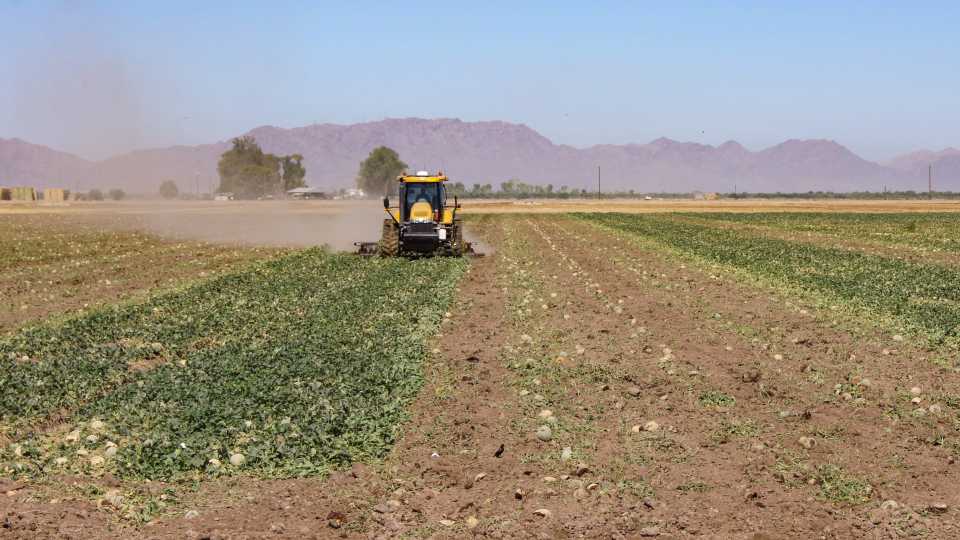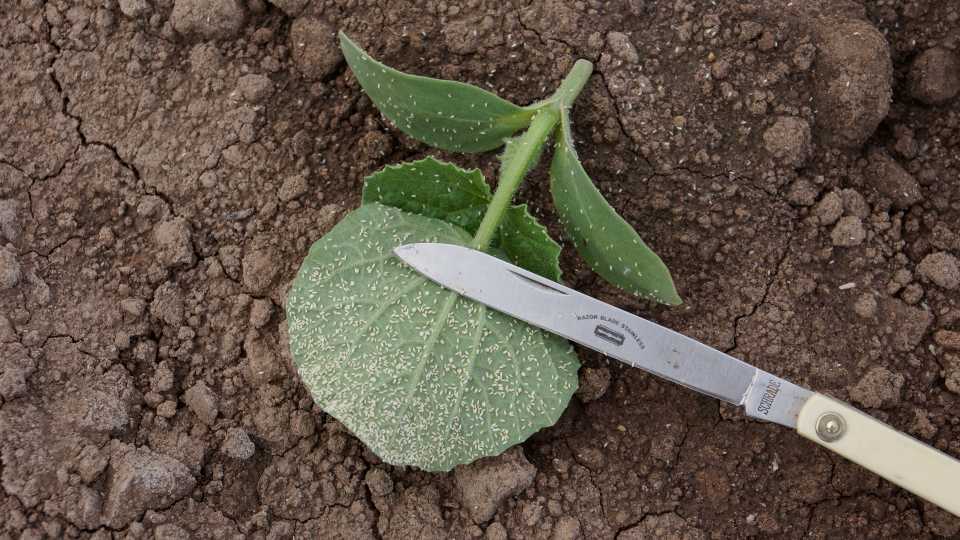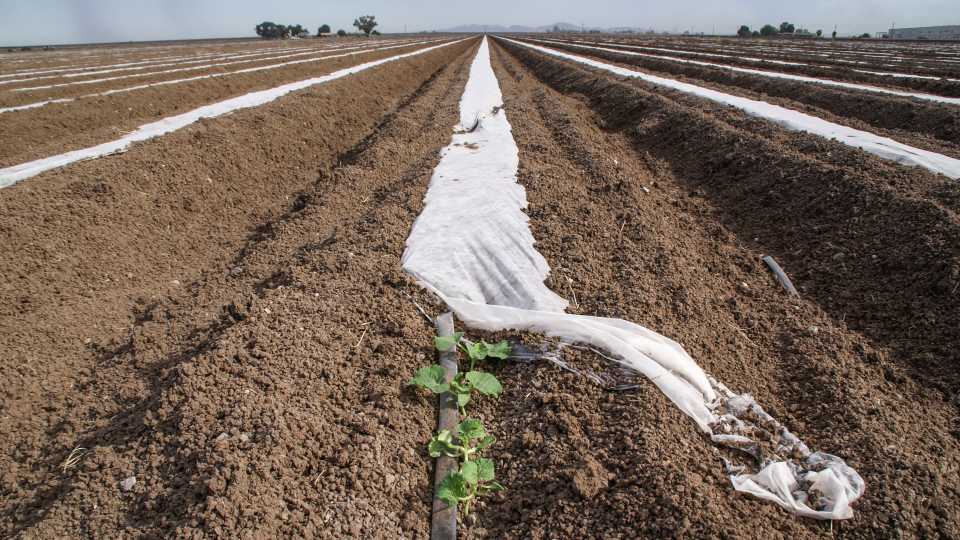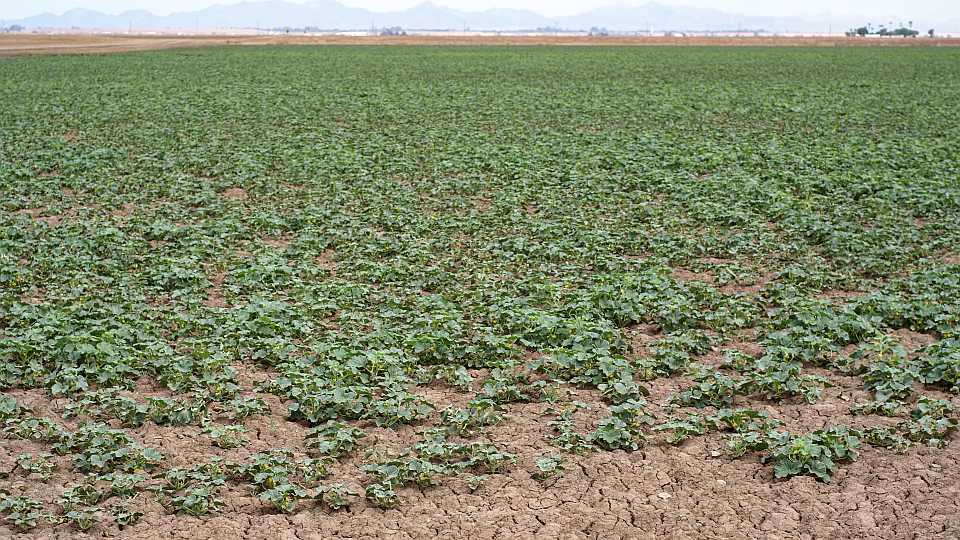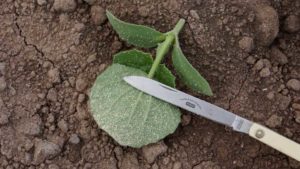A New Way to Control a Deadly Virus in Desert Melons
The sweetpato whitefly, Bemisia tabaci (B-biotype), is an economically important pest of cantaloupes, honeydews, and mixed melons grown in the Desert Southwest. Not only do whiteflies cause direct reductions in yield and quality, they vector a devastating plant virus.
Historically, sweetpotato whitefly was managed in melons through an integrated approach that stressed conserving natural enemies and the judicious use of selective insecticides to control whitefly immatures.
However, that approach changed after 2007 when a new crinivirus, cucurbit yellows stunting disorder virus (CYSDV), appeared. It’s vectored solely by adult sweetpotato whiteflies and is now a semi-persistent virus that has been causing significant economic losses in fall melons for the past 13 years.
To manage CYSDV, growers have focused on avoiding virus transmission by whitefly adults. They typically use an aggressive chemical control approach: apply systemic insecticides in the seedbed, below the seed at planting, then a side-dress application 14 to 20 days after planting. Growers augment that with foliar-applied insecticides throughout the season to reduce a secondary virus spread within the field.
This management approach can be hard on natural enemies and disrupt pollination by honeybees. Furthermore, dependence on insecticides is not only expensive but increases the risk of resistance, particularly to the neonicotinoids.
Fortunately, research over the past decade shows techniques that help reduce insecticide usage while mitigating the impact of the virus on melon production.
Cultural Management/Avoidance
In the past, a key strategy to managing CYSDV and avoiding economic losses in melons was to find a way to prevent whitefly populations migrating from spring and summer melon crops onto fall melons.
After CYSDV first appeared in the desert, local growers attempted to abate whitefly movement onto fall melons by creating of a 25-day “host-free” period where operations avoided growing melons during July. Unfortunately, establishing this melon-free bridge between crops didn’t succeed.
This was due to the preponderance of volunteer melons from previous spring crops. Also, we discovered alfalfa and several common weeds (common mallow, groundcherry, and silverleaf nightshade) serve as reservoirs for CYSDV.
Growers soon learned they could employ other cultural practices to minimize the host availability for CYSDV and movement of whiteflies onto fall melon crops.
Crop Management
Maintaining strong, healthy plants minimizes whitefly issues. Optimal growing practices avoids stressing melon crops. That includes properly managing irrigation, plant nutrition, and salinity. A vigorously growing plant is better able to withstand external stresses from whitefly feeding and virus infection. It’s the infection that delays growth and reduces yield potential.
Sanitation
In preparing to establish new melon plantings, growers should be aware of adjacent crops in the cropping landscape. For example, host crops approaching harvest (e.g., vegetable seed crops, cotton, and alfalfa) and weeds are usually the primary sources from which adult whiteflies migrate.
Sanitation and clean culture are perhaps the most important cultural practices that can be employed on an area-wide basis.
Remove whitefly- and CYSDV-host plants in the area where you’ll grow fall melons — doing so can reduce virus transmission. This includes rapidly destroying plant residue following spring melon harvest. Plant residue not only serves as a reservoir of CYSDV, but for whiteflies too.
Destroying volunteer melons between spring and fall crops can reduce the source of virus inoculum available. As soon as it is practical, remove emerging volunteer plants. You can do this by disking or applying a contact, burn-down herbicide to fields soon after volunteers emerge.
Crop Placement / Isolation
Carefully consider crop sequencing and planting dates. Doing so can significantly impact adult whitefly dispersal onto fall melons.
Whenever possible, plant fall melons as far away as possible from previously grown spring melons. Research demonstrates fall melons planted near locations where spring or summer melons were previously grown (within less than 1.8 miles) are at a high risk of CYSDV infection.
Also plant fall melons as far away as possible from cotton, alfalfa, and other host crops that serve as a reservoir for whiteflies. Recent research shows fall melons grown within one mile of cotton are at a higher risk of CYSDV infection. Cotton is a potential source of large whitefly populations and harbors virus infected weeds and volunteer melons within the field.
Avoid planting near residential subdivisions and citrus/date orchards, both of which may contain sources of infected weed hosts.
Row Covers
Lightweight, fabric row covers have been successfully deployed in both experimental plots and commercial melon fields to delay virus incidence and severity.
Covers must be on the seed bed prior to plant emergence to prevent adult whiteflies from feeding on emerging seedlings and transmitting CYSDV. You must remove covers prior to blooming to ensure adequate pollination of the crop, however.
Use a foliar insecticide spray immediately following removal when whiteflies actively migrate into the field. Keep in mind, deploying these covers is often labor intensive and expensive.
Our experience in the Desert Southwest indicates that crop isolation, elimination of volunteer melons during the summer, and timely insecticide applications have collectively been effective in managing whiteflies and suppressing CYSDV in fall melon fields.






